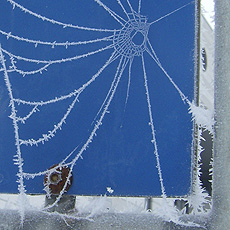Freezing particle beams and other things
 |
| This spiderweb was overtaken by a sudden frost.
|
The last few days have been cold. Really cold. It prompted me to make some comparisons: cold as outer space, cold as laser beams, cold as an electron — but most of these are nonsensical. The concept of temperature only makes sense in settings with large numbers of particles and a diffuse distribution of energy, such as our everyday world. A single particle doesn't have a temperature, and the temperature of a laser beam is negative (below absolute zero).
Temperature is a relationship between the energy of a system of particles and its complexity, also known as entropy (see "Entropy is not disorder"). An ice crystal is an example of a simple, or low-entropy, state because the water molecules are aligned in rigid positions. Hot water is a more complex, high-entropy state because there are so many ways that the water molecules can tumble over one another. If it takes a lot of energy to increase the entropy a little, then the temperature is high. If it doesn't take much, then the temperature is low.
This is why an isolated particle has no temperature. It has energy but no entropy because there is only one configuration — like a single Lego brick, all alone. A bunch of particles, such as the electrons or protons in a particle beam, has energy and entropy, so you can measure the beam's temperature. If all the particles are in rigid lockstep and racing down the beam pipe with a lot of energy, it is a low-temperature beam, like a flying ice cube. In fact, cooling is an important step in preparing the beam: The random motions of the initial gas must be dampened while its collective motion is accelerated. The energy of the collective motion doesn't count toward temperature because changing the overall speed doesn't change the entropy.
Lasers are even more exotic. The source of a laser beam is made of atoms with only two (relevant) energy states: on and off. When more than half of the atoms are "on," the laser's entropy decreases, rather than increases. Half-on and half-off is a more complex state than all-on. Thus, as the energy increases, turning more atoms "on," the entropy decreases, and the temperature is negative.
Even in this bizarre case of negative temperature, absolute zero cannot be reached. Zero temperature means that a change in energy would cause an infinite change in entropy, and since entropy is ultimately a count of the number of configurations, it cannot be infinite. Laser beams approach but do not reach absolute zero from below, just as normal systems approach it from above.
So how cold is it outside, in an absolute sense? Zero degrees Fahrenheit, relative to absolute zero, is 10 percent colder than 45 degrees Fahrenheit, so if you're looking for a strong statement about the weather, we're a 10th part closer to absolute zero than we were two weeks ago.
—Jim Pivarski
Want a phrase defined? Have a question? Email today@fnal.gov.
|